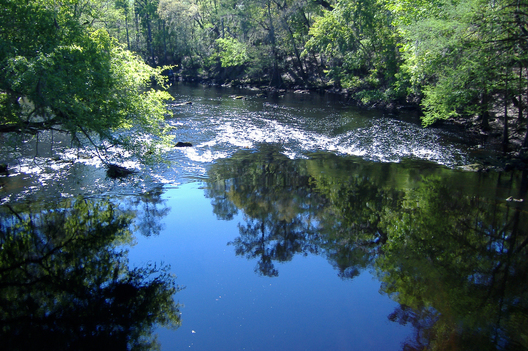FOR IMMEDIATE RELEASE: June 28, 2012
STATE TO INVEST NEARLY $1 MILLION IN SANTA FE RIVER BASIN RESTORATION EFFORT
~Suwannee River Water Management District to receive additional funding to address both water quality and water supply in the Santa Fe~

TALLAHASSEE - The Florida Department of Environmental Protection announced today its commitment of up to $900,000 to fund the efforts to restore the Santa Fe River and its associated springs.
In coordination with the Florida Department of Agriculture and Consumer Services and the Suwannee River Partnership, the Suwannee River Water Management District will use this additional funding to provide water quality and quantity improvements that will help address both nutrient and water supply issues in the Santa Fe River Basin. By directing this funding to advanced technologies, the water management district will work with area farmers to keep more than 1 million pounds of nitrogen from entering the river and springs and save 670 million gallons per year of water use.
"DEP shares the concerns of local residents and river enthusiasts when nutrient impacts, such as algae blooms, prevent us from enjoying our beautiful waterways," said DEP Secretary Herschel T. Vinyard Jr. "We are committed to working with local governments and stakeholders to implement both long- and short-term strategies to address nutrient impacts in the Santa Fe River basin."
This new funding is in addition to over $25 million in projects recently committed by local stakeholders to achieve restoration and monitoring in the Santa Fe River basin.
In February, DEP culminated more than two years of work with local governments and environmental and agricultural stakeholders to develop and adopt a Basin Management Action Plan (BMAP), a five-year blueprint for reducing nutrients in the Santa Fe River. During the plan development, restoration partners identified nutrient and irrigation management as the two key categories of agricultural practices that need to be addressed in order to achieve restoration.
This partnership will achieve both. The funds, which come from the state’s TMDL program appropriation, will be used to retrofit existing irrigation systems to more efficiently distribute water and incorporate the practice of fertigation. This involves the application of fertilizers, soil amendments, or other water-soluble products through an irrigation system. The practice of fertigation will increase water conservation and save money for growers as well.
The benefits of fertigation include:
- Increased nutrient absorption by plants.
- Reduction in fertilizer and chemicals needed.
- Reduced leaching to the water table.
- Reduction in water usage due to the plant's resulting increased root mass' ability to trap and hold water.
- Application of nutrients at the precise time they are needed and at the rate they are utilized.
- The grower's ability to change fertilizer program during the growing season in order to adjust for fruit, flower and root development.
"These reductions in water use and nutrient loading will benefit both the river, and the plants and animals that reside in and around it. It will also benefit the farmers, by saving them money by decreasing their fertilizer and fuel use and potentially increasing crop yields," said Suwannee River Water Management District Executive Director Ann Shortelle. "Most importantly, applying this technology, which includes retro-fitting center pivot irrigation systems, will speed up implementation of the Santa Fe BMAP and allow restoration to begin even sooner."
This effort demonstrates the dedication of local governments, businesses and stakeholders to the restoration of the Santa Fe River by reducing the nonpoint source discharges of pollutants that end up in the river and will help achieve water quality standards and designated uses established by DEP. The phased approach outlined in the BMAP involves implementation of actions such as agricultural and urban best management practices, improved stormwater management and increased wastewater reuse alongside activities such as continued water quality sampling to better control and understand the sources of these pollutants. The implementation of BMAP actions will decrease the levels of nutrients that ultimately end up in the Santa Fe River and its associated springs.
|